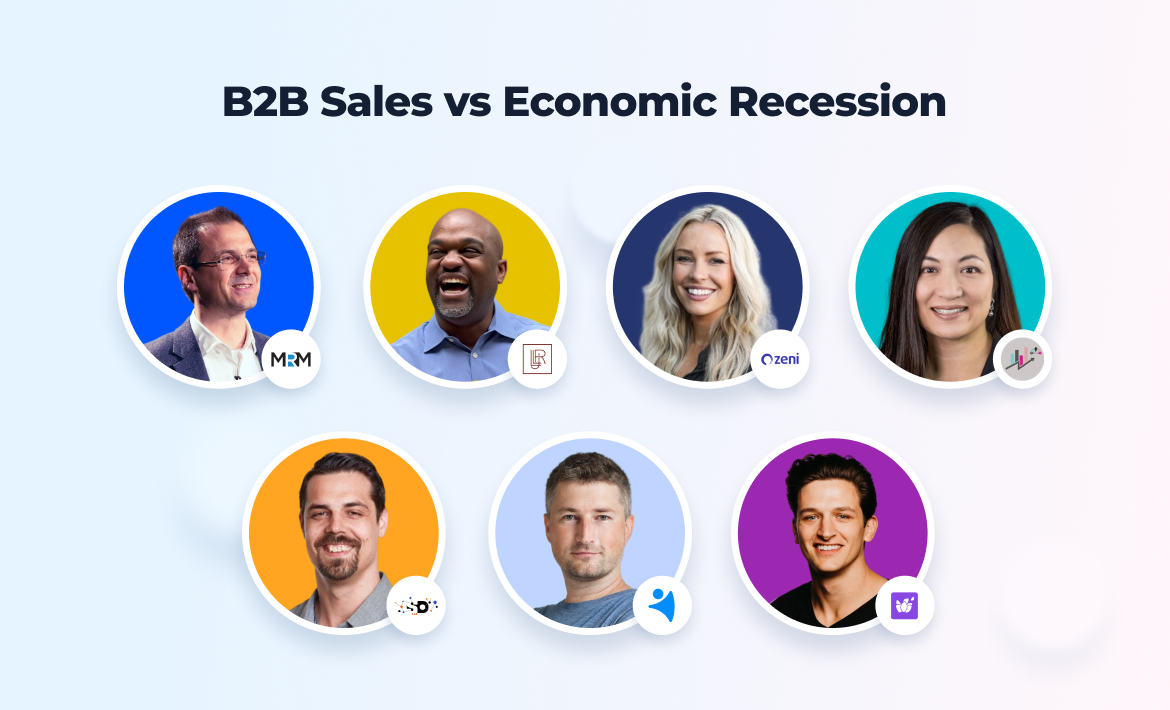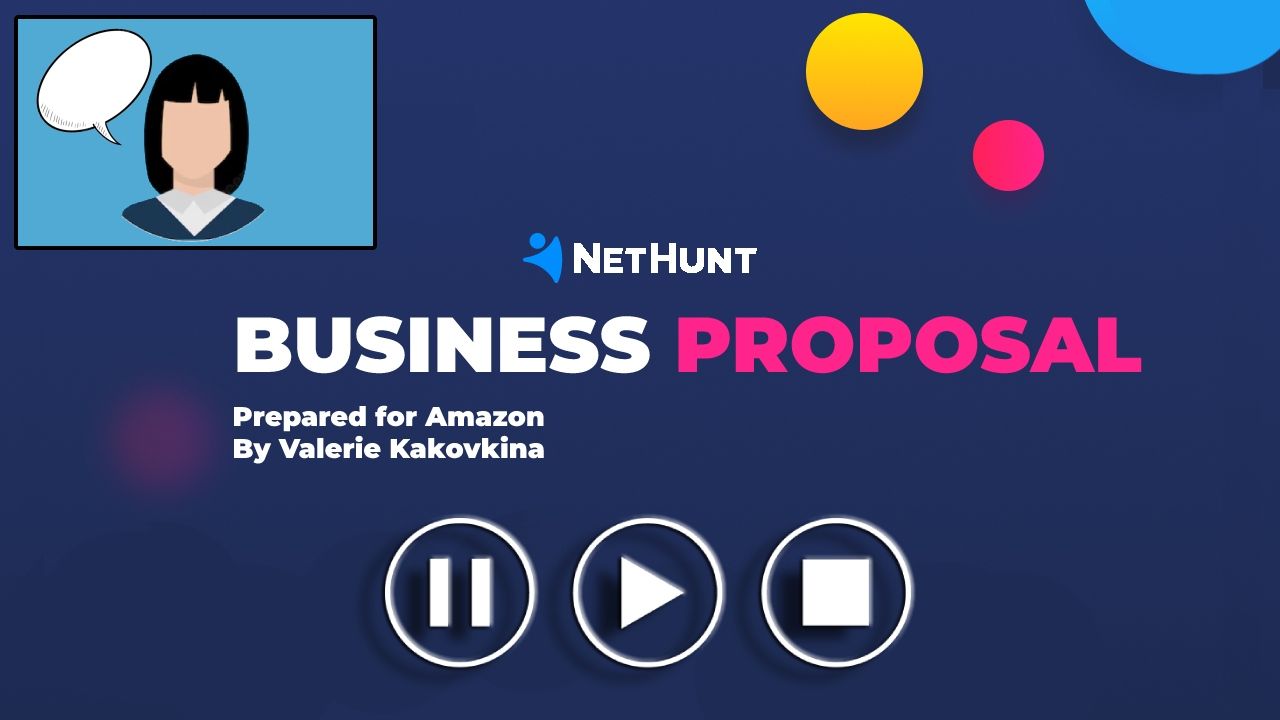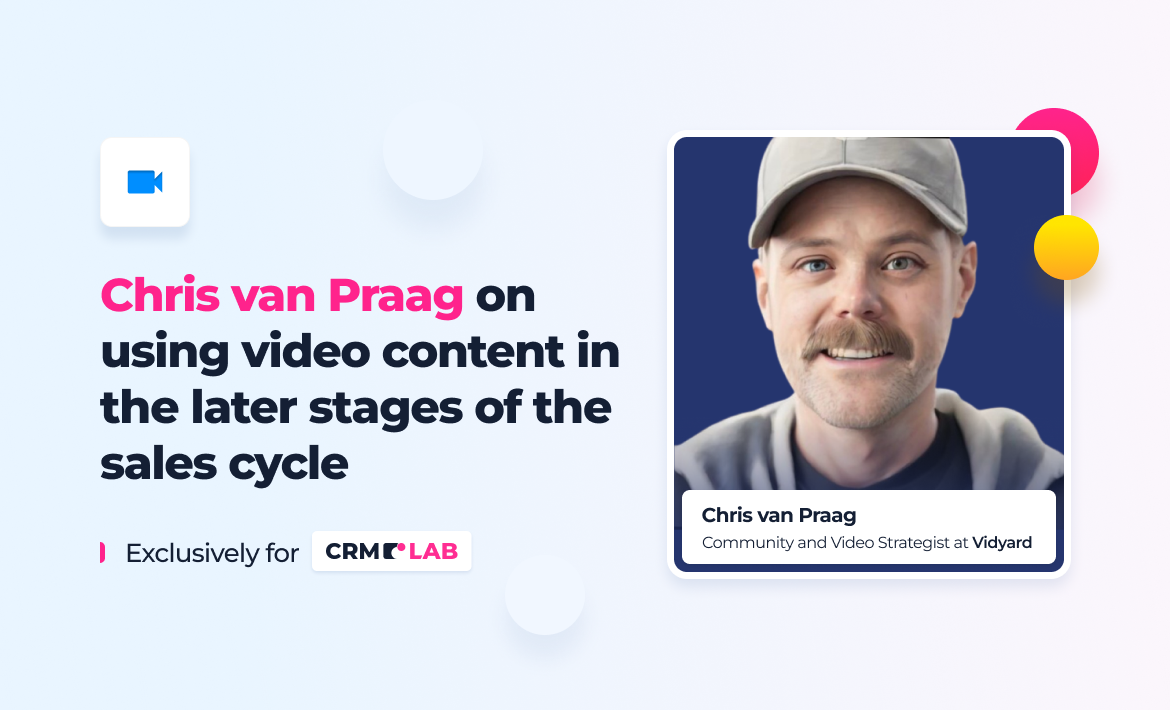In the realm of sales, video is often associated with prospecting and initial pitches. However, its potential extends far beyond the early stages.
To help you unleash the untapped power of video in the later sales stages and find your way around using video for closing deals, we reached out to the master of sales video…
Meet Chris van Praag. He’s a prominent figure in the B2B SaaS world, specialising in the dynamic field of video for sales. With over three and a half years of experience in this realm, Chris's journey began during the onset of the lockdown when he discovered the game-changing potential of video in sales as a Vidyard user.
Captivated by its benefits, he transitioned from a satisfied customer to a full-cycle Account Executive at Vidyard.
During his tenure as an AE, Chris delved into creating compelling video content, enlightening others about the power of video in sales. This pivotal shift led him to transition from a sales representative to a key member of the marketing team.
Who is Chris van Praag?

Chris van Praag a passionate sales evangelist. His mission is to champion, advocate, and promote the use of video for sales professionals throughout the entire sales cycle.
Collaborating closely with Vidyard's esteemed clientele, Chris shares invaluable insights to enhance success with video. Moreover, he actively spreads awareness regarding the profound impact of video across the sales and marketing funnel, offering invaluable tips, tricks, and feature updates from Vidyard, the leading platform for business video hosting and creation.
Get ready to discover the transformative potential of video for sales — specifically video for closing deals — with Chris van Praag as your guide.
The value of video content for closing deals
— Why is video content valuable for salespeople in closing deals? How does it compare to other types of content?
Video is an excellent way for salespeople to stand out.
In today's B2B landscape, buying cycles are longer. Competition for deals has intensified, and there is a surge in platforms vying for client attention.
With everything going on in the economic climate right now, budgets are tight. Salespeople need to use every single available channel to meet their prospects where they want to be met.

In our daily routines many of us regularly consume video content, whether it's watching TV, learning from YouTube (now the world's largest search engine), or scrolling through TikTok. Video has become an integral part of our lives, helping us engage and learn in a more immersive way.
It's only natural for salespeople to leverage video as a communication tool. Not only does video showcase their personality and humanise them — an important challenge for salespeople — but it also offers a visually compelling way to demonstrate how they can address the needs of their prospects.
Whether it's walking through a proposal or sharing a concise demo video, video empowers salespeople to convey their value and problem-solving abilities effectively.
Moreover, video content in your communication with leads helps you stay relevant and memorable, especially when competing with other companies for your lead’s attention (and money). We often hear that price plays a big role, but here's the thing... Many products have similar prices. So…
The salesperson who genuinely showcases their personality and stays top of mind has a better chance of sealing the deal.
?️ Chris van Praag
When it comes to communication, video beats text-based emails any day. Lengthy blocks of text are easily forgettable, as our brains struggle to retain them.
On the other hand, as confirmed by the study Vidyard has done with neuroscientists, video is much more memorable. It leaves a lasting impression that sticks in our minds.
If salespeople want to make a lasting impact and stand out, video is the super effective way to go and close the deal.
Examples of video content helping to close deals
— Can you share a real-life success story where using video content in the later sales stages made a significant impact on closing a deal?
Sure! I’d like to start by saying that the average increase in close rates when salespeople start incorporating video content at the later stages of the sales cycle is around 42%.
We had a customer who found a clever way to use video and reduce the workload for their solution consultants. You see, they sell a rather complex technical solution, and their solution consultants were overwhelmed with questions and demo requests.
To free up their consultants' time to focus on closing deals or providing valuable education to the team, the business created asynchronous videos. Instead of joining repetitive calls to answer the same questions over and over again, they made videos explaining common things like how their API works.
Now, whenever someone asks a familiar question, instead of scheduling another call, the consultants simply share the relevant video. It's a total time-saver!
Another customer managed to slash their sales cycle by 50% by when they started using video content to introduce themselves to key stakeholders and share crucial information instantly.
Instead of waiting for a scheduled call to discuss complex details that required immediate attention, they recorded videos and shared them right away. This allowed them to bypass the delays caused by scheduling conflicts, streamline their communication process, accelerate decision-making, and ultimately close deals much faster.
We also see video being effectively utilised in account management to drive upsells and build strong customer relationships, especially in remote work. It's a fantastic way to showcase your personality, demonstrate your understanding of the customer, and discuss new products or features.

Instead of inviting customers to join a call to discuss potential purchases, you can simply share a video explaining how a product or feature will address their specific needs. This allows customers to understand and visualise the value without salespeople having to schedule additional calls.
Effective video formats and styles of video for capturing prospects’ attention when closing deals
— What creative video formats or styles have you found effective in capturing prospects' attention during the crucial later stages of the sales process?
I think showstopping creativity is more important during the earlier stages of the sales cycle. Prospecting, in particular, when you really try to lure your prospect in and need to stand out from the rest of the businesses competing for their attention in the inbox.
➡️ Read our article to learn how to get a prospect’s attention in a cold email!
If we’re talking specifically about later stages, it should be said that these tricks are becoming less effective. However, there are definitely a few video formats to add to your arsenal and start closing deals more successfully.
For instance, screen sharing to walk through a proposal is really powerful.
In the past, when you get to a certain point in the sales process with a lead, you know that they’re keen and want to hear the proposal. Unless you booked a face-to-face meeting with them, the only option was to share a document.
There are document sharing tools that provide insights into page views and specific sections that attract leads' attention, but they lack the ability to facilitate real-time communication and explanation. That's where video steps in.
With video, you can justify costs, elaborate on the specific offerings, and add that personal touch to your communication.
I recommend including an overlay of you in the corner of the video, pointing out specific elements of the proposal that hold the most value to your lead.

Why is this important?
Well, sometimes the proposal gets passed on to a senior stakeholder who has the final say.
If you're not there to explain the value, you're relying on your champion to do it for you. But here's the catch: Your champion may not be equipped to articulate the value effectively because it's not their primary role. They might simply hand over the proposal, the stakeholder sees the price, and decides it's not the right time due to budget constraints.
Video allows you to be in the picture (literally), address sales objections and explain the value directly to the key stakeholder.

Speaking of stakeholders, one type of video you shouldn't overlook is a video introduction. It's not about replicating a specific format or style, but rather introducing yourself through video to key stakeholders that you haven’t had a chance to meet.
Finally, we see an increase in sales reps using apps like Canva or CapCut to edit their videos and make them stand out. They upload edited videos onto platforms like Vidyard or Loop with the goal to create more interesting and intriguing videos that capture attention at a time when attention spans are at an all-time low.
A punchy, engaging, and exciting video has a greater chance of being shared around the office that you're sending it to. This can help salespeople stand out in a competitive market and improve close rates.
So, don't be afraid to try new things. Seek inspiration from others who are doing interesting stuff.
The optimal amount of editing for sales videos at the later stages of the sales cycle
— When it comes to videos later in the sales cycle, what works better: A heavily edited video with a "wow" effect or a raw video that feels personal, like a message from a friend? Does it depend on the situation?
Yes, it absolutely depends on the situation.
There are two things to consider.
First, it’s obviously a time issue to edit a video to send to the lead. I fully appreciate that not all salespeople have the time to go into an app and edit the video, they have other things to take care of.
Then, the other key piece is knowing who you’re selling to and how well that’s going to land.
If you have a strong relationship with your champion and know that a simple walkthrough with your face popping up in the corner will benefit them, go for it.
There isn't a hard and fast rule that dictates always using heavily edited videos. Sometimes it may just not be suitable for the industry or ideal customer profiles that prefer a more formal approach.
Prospecting, using a GIF or meme can be a great way to break the ice with the right person. But when you know the person on the other side isn’t into that kind of stuff, it’s best to be more reserved.
Finding a balance is key. There's no definitive answer, but I encourage people to try different approaches, especially when they have a strong relationship with a champion or hold valuable insights about senior stakeholders. Going the extra mile can make a difference.
For example, if you know a senior stakeholder is passionate about surfing and shares their experiences on LinkedIn, consider recording a video at a local beach to show you've done your research and connect on a more personal level. It humanises you and demonstrates your understanding of their interests, helping you stand out from the crowd.
Personalising sales video content at a scale: Possible or not?
— Is there a way to streamline the process of incorporating personalised video content at scale?
Personalisation at scale is a bit of an oxymoron.
While AI is advancing in this area, there’s no magic way to be really personal at scale. At the moment, if you want to be personal, it's about taking the time. You can't just make a one-size-fits-all video that you can use for everybody to increase close rates. Recording a video proposal walkthrough once and sending it to every lead in the sales pipeline won’t cut it because each proposal should be unique.
When you reach the later stages of the sales process, you're not fighting for the lead's attention as much as you were during cold outreach.
By the time you're ready to record a video that will convert the lead into a paying customer, you've likely already had several interactions with them, including discovery calls, demo calls, and other exchanges. At this point, the need for a "mass scale" approach diminishes.
It's more about personalising your communication for that specific lead and tailoring your video to the specifics of your relationship.
However, there are definitely some things you can do to protect yourself from spending too much time on incorporating video in the sales process.
For instance, you can use more videos that you know have resonated in the past. Let's face it, not many sales reps are taking advantage of video yet. When you go above and beyond to create a video for a prospect or stakeholder, you'll probably get some positive feedback. If people are genuinely excited and enjoy your videos, it's a clear sign that you should keep using them in your sales approach.
Resend videos
Another thing that can save you a lot of time is resending videos.
If your video wasn’t watched, don't just give up and assume it didn't resonate.
Remember, stakeholders are busy and there may be tough competition with other vendors. Maximise the impact of your carefully crafted video; don't hesitate to share it on LinkedIn, through a WhatsApp message, or any other platform where you know you'll have a better chance of success.
This gives you the opportunity to asynchronously connect and show your face, increasing the likelihood of engagement and, ultimately, deal closure.

Account-based videos
One more alternative is account-based videos.
If you’re not sure who the stakeholder is or you’re sending it to a number of people, you might not want to send personal videos to each of them individually. Instead, make one that mentions the company name and talks about the businesses’ challenges or say the names of all stakeholders in one video.
Still, I encourage people not to have a single video that they send to every single lead after a discovery.
You could easily create a video that goes something like this…
“Hey! Great to meet you! Just now, we’ve chatted about some really interesting topics. I’m gonna send you a follow-up email shortly. Looking forward to seeing you at the next call!”
Yes, it’s a video. But it’s a video that ultimately means nothing. It doesn’t add any value. You actually lose authenticity by doing that.
On the other hand, something like…
“Hey {{Name}}. We had a conversation about {{the topic}}. You told me that X, Y, and Z were the most important things. Please, correct me if I’m wrong. I’m going to build my proposal based on what you’ve said.”
It becomes a lot more personalised as you clearly demonstrate that you’ve listened to your lead attentively during the call, understood their challenges, and know exactly what kind of solution they need.
➡️ Learn how to personalise your communication using CRM data in our article.
How much video is too much in sales?
— How much video is too much? Doesn’t it get a little bit too repetitive when you try to use the video format for every piece of information you share with a lead? Perhaps, there’s a specific formula you’d recommend?
Many salespeople primarily use video as a content format for prospecting. Once they have the prospect's attention, they often shift back to their usual tactics of email and phone calls to move the lead through the sales funnel. If this approach is working for them and they're hitting their quotas and closing deals, there may be no immediate need for them to incorporate more video into their process.
However, if salespeople find themselves losing deals or looking to improve their close rates, video can be a valuable tool to consider.
Can you send too much? Probably. You can send too much of any content via any channel.
It's important to gauge the lead’s interest and responsiveness to determine the appropriate frequency and timing of video communication.
I also think a deal could easily fall apart if the sales rep is sending too much pre-recorded, generic content. Instead of overwhelming the SQL with multiple case studies and social proof, it's more effective to send a targeted case study that specifically demonstrates how your business successfully addressed a similar problem.
On the other hand, when video content genuinely adds value and is tailored to the prospect's needs, there is no strict limit on how much can be sent.
Unexpected challenges associated with using video content during the later stages of the sales cycle
— What are some unexpected challenges sales professionals may face when incorporating video content in the later sales stages, and how can they overcome them?
Salespeople speaking for too long in their videos, for sure.
It’s a major problem at the start of the sales process, prospecting videos are often too long. Even if the prospect clicks on your message and sees that you shared a video, its length will discourage them from watching it.
That still applies later on in the sales cycle.
It’s a particularly common issue for business proposal walkthrough videos. There is a tendency for reps to spend three or four minutes walking through an entire PDF file page-by-page without focusing on the key areas that are most relevant to the prospect.
Often, sales reps will also apologise for the price of the product, instead of emphasising the value it can deliver.
To address these challenges, it's crucial to focus specifically on the areas of proposal that are important to the lead.
Be confident
Be confident in explaining why it's worth the price tag. Think about it this way: if your video gets passed along to a senior stakeholder who cares about those specific points, they won't want to sit through three minutes of you rambling on about irrelevant stuff. They want the meat and potatoes; the stuff that matters.
Cut the fluff
So, cut the fluff and get straight to the point. Highlight what's important, address their pain points, and show them the value. Think about the return on investment and how your solution can make a real impact on their business. That's what they care about. Don't waste time with unnecessary details. Keep it snappy, keep it focused, and you'll have a better chance of capturing their attention and sealing the deal.
Break it down
If you find that your video needs to be a bit longer, around 2 or 3 minutes, you can break it down into chapters. That way, you can provide a clear structure and guide your prospect through the content. In your email, you can mention the different chapters and let them know which sections cover specific topics. For example, you could say something like,
"Hey, if you're interested in pricing, feel free to skip to chapter three, or if you want to see the case study we discussed during our discovery call, check out chapter two."
Key metrics for assessing the effectiveness of video content later in the sales cycle
— What metrics or key performance indicators do you focus on to assess the effectiveness of video content in driving deal conversions during the later sales stages?
Views and engagement.
When it comes to the later stages of the sales cycle, views on your video proposals are important.
You want to ensure that the time and effort you put into creating those videos are actually adding value. So, keep an eye on metrics like views, engagement, and how long people are watching for. If you notice that your video proposals are only being watched about 80% through, it might be a sign that they're too long.
You need to get to the point quicker because people's attention can trail off if you're not capturing it early on.
Consistency is key when it comes to measuring the impact of video. If you decide to use video content and incorporate it into different parts of your sales process, make sure everyone on your team is on board and doing it consistently. By doing so, you can start seeing the real impact it's having.
Vidyard, for example, integrates seamlessly into CRM systems, allowing you to track and measure the effects of using video. This way, you can establish a framework for video usage, including video length, and even A/B test different video types. It saves you from wasting valuable time and enables you to gain insightful knowledge about what's working best.
Emerging trends associated with the use of video for sales
— Looking ahead, what emerging trends or technologies do you anticipate will revolutionise the use of video content in unlocking greater sales potential in the later stages of the sales process?
AI is definitely making an impact, and video is no exception.
There are already platforms out there offering AI-generated videos, trying to tackle the challenge of reps not wanting to create videos themselves.
In my opinion, that technology still has a long way to go. We're aiming for a human-to-human connection here.
I believe it will improve over time. We might see AI taking on more of the top-of-the-funnel prospecting role, at least in understanding who's clicking on videos.
As we mentioned earlier, not everyone is into video content. By using AI to identify those who engage with videos, we can then choose to create personalised videos specifically for them.
It's like saying, "Hey, I noticed you watched my video. Now let's dive deeper into your specific needs."
With larger buying groups and increased competition, the need to stand out and use more videos is becoming greater. That's why another important trend we're seeing is salespeople becoming their own content generation engines.
They're taking matters into their own hands to create personalised content and make an impact.
Let's face it, marketing and enablement teams can't create individualised content for every sales rep. It's just not feasible. So we'll start to see more reps stepping up, using tools to create videos that grab attention and go the extra mile. These are the reps who will shape the future of sales teams, and it's something we should encourage.
In conclusion, video content is a game-changer in the later stages of the sales cycle. It captivates prospects, forges connections, and boosts conversions. By using compelling formats, finding the right balance in editing, and personalizing at scale, sales professionals can maximize its impact.
























 product experts — let's find the best setup for your team
product experts — let's find the best setup for your team